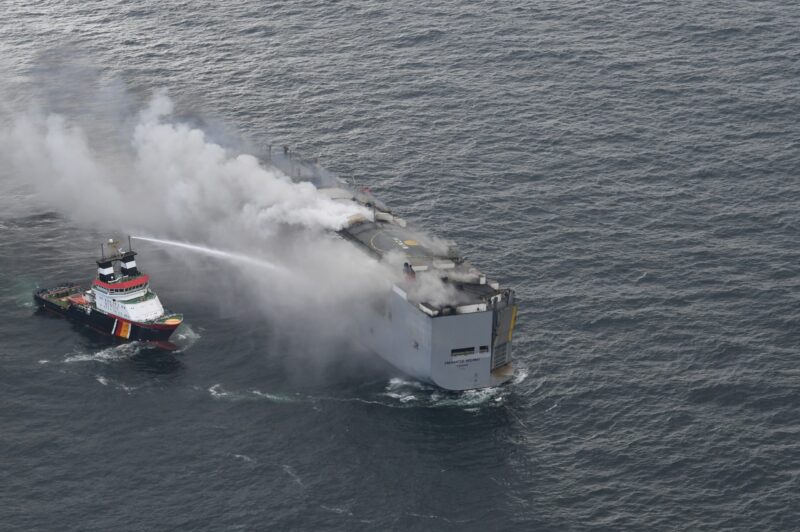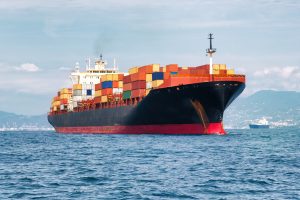There are growing concerns within the shipping community, including marine underwriters, about fires breaking out on car carriers and roros with the assertion that many of these fires are attributable to electric vehicles. In response, the International Union of Marine Insurance (IUMI) has researched these claims and published recommendations on the safe carriage of electric vehicles (EVs).
“Our paper draws on a body of scientific research which demonstrates that fires in battery EVs are not more dangerous than fires in conventional vehicles, nor are they more frequent,” commented Lars Lange, IUMI Secretary General. “Although statistics continue to be gathered, they currently estimate that, in general, there are fewer fires from EVs compared with fires from conventional vehicles when driven over the same distance.”
The recommendations come shortly after the Fremantle Highway (per photo), a pure car and truck carrier (PCTC) chartered by “K” Line, caught fire in July in the North Sea off the coast of the Netherlands while transporting some 3,800 new vehicles, including some 500 EVs. The cause of the fire is still under investigation, but there is speculation that the fire may have started from an EV battery.
Research also proves that there is only a minor difference between total energy released during an EV fire and one that is related to an internal combustion engine vehicle (ICEV). Once established, vehicle fires are largely (approx. 80%) fuelled by the car body and interior parts rather than the propulsion system. However, the potential for thermal runaway (when the battery suffers an unstable chemical reaction) exists for EVs whereas it is not a consideration for ICEVs. Thermal runaway makes fires hard to extinguish, hence mitigation measures such as boundary cooling must be employed rapidly. Moreover, the risk of re-ignition is higher for an extended period of time.
In the paper, IUMI makes important distinctions between roros and pure car and truck carriers (PCTCs) noting that many roros will stow cars on open decks where air flow makes fire-fighting more challenging. Ropax vessels (where passengers are also carried) present additional issues such as passengers wanting to charge onboard and the possibility of cars being loaded that are older and potentially less safe. Conversely, PCTCs tend to carry vehicles tightly packed leaving little room for emergency access and facilitating the rapid spread of a fire.
In light of this, IUMI concludes:
- Early fire detection and verification/confirmation is critically important to reduce the time between detection and firefighting response to a minimum. Options, in addition to the conventional systems, could include thermal imaging cameras and AI powered systems.
- Drencher systems are effective for fire-fighting onboard roro and ropax vessels both for EV and ICEV fires and should be installed alongside video monitoring systems.
- CO2 extinguishing systems, if applied quickly, are successful in fighting PCTC fires and their capacity should be doubled. High-expansion foam fire extinguishing systems have also proved to be effective to prevent heat transfer from one vehicle to another.
- Early detection, confirmation and a short response time are crucial to fight a fire successfully. On board PCTCs, fixed systems should always be applied before manual fire-fighting is employed.
- A clear policy is required on which cargo is accepted or rejected. Vehicles should be screened with used vehicles being checked carefully for hidden damage.
- Charging onboard ropax vessels should be permitted subject to relevant risk assessments and control measures. Safety mechanisms built into EVs are usually activated during charging.
(Dreamstime photo of Freemantle Highway on fire in the North Sea on July 26, 2023 off the coast of The Netherlands)








